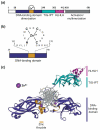B lymphocyte lineage specification, commitment and epigenetic control of transcription by early B cell factor 1
- PMID: 21735360
- PMCID: PMC3925327
- DOI: 10.1007/82_2011_139
B lymphocyte lineage specification, commitment and epigenetic control of transcription by early B cell factor 1
Abstract
Early B cell factor 1 (EBF1) is a transcription factor that is critical for both B lymphopoiesis and B cell function. EBF1 is a requisite component of the B lymphocyte transcriptional network and is essential for B lineage specification. Recent studies revealed roles for EBF1 in B cell commitment. EBF1 binds its target genes via a DNA-binding domain including a unique 'zinc knuckle', which mediates a novel mode of DNA recognition. Chromatin immunoprecipitation of EBF1 in pro-B cells defined hundreds of new, as well as previously identified, target genes. Notably, expression of the pre-B cell receptor (pre-BCR), BCR and PI3K/Akt/mTOR signaling pathways is controlled by EBF1. In this review, we highlight these current developments and explore how EBF1 functions as a tissue-specific regulator of chromatin structure at B cell-specific genes.
Figures



Similar articles
-
The regulatory network of B-cell differentiation: a focused view of early B-cell factor 1 function.Immunol Rev. 2014 Sep;261(1):102-15. doi: 10.1111/imr.12206. Immunol Rev. 2014. PMID: 25123279 Free PMC article. Review.
-
Dynamic EBF1 occupancy directs sequential epigenetic and transcriptional events in B-cell programming.Genes Dev. 2018 Jan 15;32(2):96-111. doi: 10.1101/gad.309583.117. Epub 2018 Feb 9. Genes Dev. 2018. PMID: 29440261 Free PMC article.
-
From hematopoietic progenitors to B cells: mechanisms of lineage restriction and commitment.Curr Opin Immunol. 2010 Apr;22(2):177-84. doi: 10.1016/j.coi.2010.02.003. Epub 2010 Mar 6. Curr Opin Immunol. 2010. PMID: 20207529 Free PMC article. Review.
-
Transcriptional repression of Gata3 is essential for early B cell commitment.Immunity. 2013 May 23;38(5):930-42. doi: 10.1016/j.immuni.2013.01.014. Epub 2013 May 16. Immunity. 2013. PMID: 23684985 Free PMC article.
-
Interaction of CCR4-NOT with EBF1 regulates gene-specific transcription and mRNA stability in B lymphopoiesis.Genes Dev. 2016 Oct 15;30(20):2310-2324. doi: 10.1101/gad.285452.116. Epub 2016 Nov 2. Genes Dev. 2016. PMID: 27807034 Free PMC article.
Cited by
-
Hypomethylation coordinates antagonistically with hypermethylation in cancer development: a case study of leukemia.Hum Genomics. 2016 Jul 25;10 Suppl 2(Suppl 2):18. doi: 10.1186/s40246-016-0071-5. Hum Genomics. 2016. PMID: 27461342 Free PMC article.
-
The regulatory network of B-cell differentiation: a focused view of early B-cell factor 1 function.Immunol Rev. 2014 Sep;261(1):102-15. doi: 10.1111/imr.12206. Immunol Rev. 2014. PMID: 25123279 Free PMC article. Review.
-
ZNF423 and ZNF521: EBF1 Antagonists of Potential Relevance in B-Lymphoid Malignancies.Biomed Res Int. 2015;2015:165238. doi: 10.1155/2015/165238. Epub 2015 Dec 16. Biomed Res Int. 2015. PMID: 26788497 Free PMC article. Review.
-
Gene expression models based on transcription factor binding events confer insight into functional cis-regulatory variants.Bioinformatics. 2019 Aug 1;35(15):2610-2617. doi: 10.1093/bioinformatics/bty992. Bioinformatics. 2019. PMID: 30541050 Free PMC article.
-
Kruppel-associated box (KRAB) proteins in the adaptive immune system.Nucleus. 2014 Mar-Apr;5(2):138-48. doi: 10.4161/nucl.28738. Epub 2014 Apr 3. Nucleus. 2014. PMID: 24699165 Free PMC article. Review.
References
-
- Adolfsson J, Mansson R, Buza-Vidas N, Hultquist A, Liuba K, Jensen CT, Bryder D, Yang L, Borge OJ, Thoren LA, Anderson K, Sitnicka E, Sasaki Y, Sigvardsson M, Jacobsen SE. Identification of Flt3 + lympho-myeloid stem cells lacking erythro-megakaryocytic potential a revised road map for adult blood lineage commitment. Cell. 2005;121:295–306. - PubMed
-
- Aravind L, Koonin E. Gleaning non-trivial structural, functional and evolutionary information about proteins by iterative database searches. J Mol Biol. 1999;287:1023–1040. - PubMed
-
- Bain G, Maandag EC, Izon DJ, Amsen D, Kruisbeek AM, Weintraub BC, Krop I, Schlissel MS, Feeney AJ, van Roon M, van der Valk M, te Reile HPJ, Berns A, Murre C. E2A proteins are required for proper B cell development and initiation of immunoglobulin gene rearrangements. Cell. 1994;79:885–892. - PubMed
-
- Bhalla S, Spaulding C, Brumbaugh RL, Zagort DE, Massari ME, Murre C, Kee BL. differential roles for the E2A activation domains in B lymphocytes and macrophages. J Immunol. 2008;180:1694–1703. - PubMed
Publication types
MeSH terms
Substances
Grants and funding
LinkOut - more resources
Full Text Sources
Other Literature Sources
Miscellaneous

